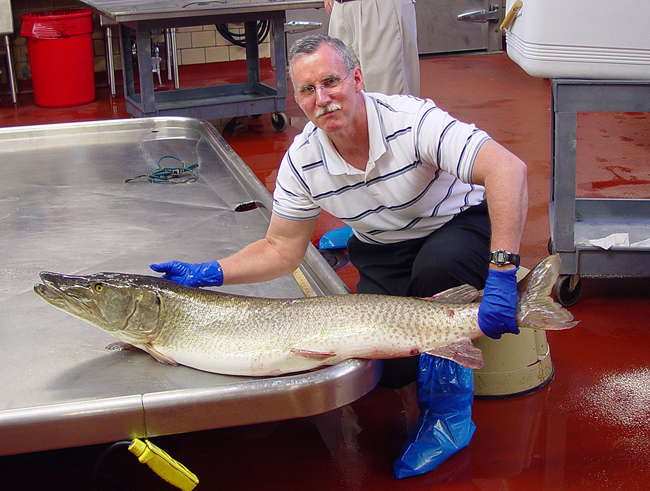Canton, NY, May 9, 2014 - Now that it's warming up, more and more people are going fishing. A lot of anglers have their eyes on muskellunge, or muskies. Muskies are popular for their size, and their ability to put up a fight.
"I've never been muskie fishing. But I know a lot of people that do, and I guess hooking into one of these fish is quite an experience! I guess it would be analogous to catching a torpedo," says David MacNeill, a fisheries specialist at New York Sea Grant, which is funding research on muskies.
If you don't see the player above, it's because you're using a non-Flash device (eg, iPhone or iPad). You can download the mp3 file by clicking here (mp3). It may take a few minutes to download, so please be patient.
Scientists have their own reasons for caring about the fish. One is that, unlike some other species, muskies are vulnerable to a disease called Viral Hemorrhagic Septicemia, or VHS.
About a decade ago, the disease slammed muskie populations in the Great Lakes and the St. Lawrence River. Thousands of muskies died. MacNeill says that was surprising. "The muskellunge are the top of the food web," he says. "They're the apex predator on the top of the food pyramid, and so their numbers are a lot lower anyway. But when you start seeing dead muskellunge in the water, that is a sign that something fairly dramatic is happening,"
MacNeill says muskie populations are now in recovery from the VHS epidemic, but the virus still exists in the Great Lakes, and on the St. Lawrence River. "It's still very much out there. And I think the dynamics of how the disease, how we get these disease outbreaks, is still not that well understood," MacNeill says.
This summer, researchers from Cornell University, and the SUNY College of Environmental Science and Forestry, will be watching the fish. Biologists will see how the muskies are coming along in their recovery. They'll also try to see what effect the long winter had on the disease.

Dr. Paul Bowser of Cornell University holds a muskellunge impacted by the VHS virus.
Photo: Bowser Lab/Cornell University
More Info: New York Sea Grant
New York Sea Grant (NYSG), a cooperative program of Cornell University
and the State University of New York, is one of 33 university-based
programs under the National Sea Grant College Program (NSGCP) of the
National Oceanic and Atmospheric Administration (NOAA). The NSGCP
engages this network of the nation’s top universities in conducting
scientific research, education, training and extension projects designed
to foster science-based decisions about the use and conservation of our
aquatic resources. Through its statewide network of integrated
services, NYSG has been promoting coastal vitality, environmental
sustainability, and citizen awareness about the State’s marine and Great
Lakes resources since 1971.
For updates on Sea Grant activities:
www.nyseagrant.org has RSS,
Facebook,
Twitter, and
YouTube links. NYSG also offers a free e-list sign up via
www.nyseagrant.org/coastlines for
NY Coastlines, its flagship publication, which, in 2014, merges with the program's e-newsletter,
Currents.
NY Coastlines is published several times a year.